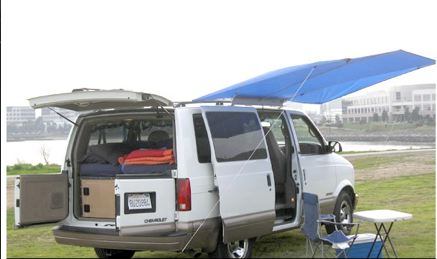Travel Tips
Eco-Friendly Green RV: The New Travel trend
 As more and more Americans struggle to find affordable ways to travel, attention has turned to the niche market of recreational vehicles.
As more and more Americans struggle to find affordable ways to travel, attention has turned to the niche market of recreational vehicles.
But is it possible for eco-minded travelers to reduce their carbon footprint—or tire tracks—when driving these behemoths?
Welcome to the world of green RVs.
The good news is that the RV industry is adjusting to the demands of a more environmentally conscious public. Vehicles are offering more efficient fuel usage and improved design, while providing spacious accommodations that can fit realistic budgets.
Modern motor homes use fuel-efficient diesel engines that get about 15 miles per gallon as opposed to the industry standard of 8-10 mpg.
Manufacturers are building RVs with lighter composites (similar to the material found in golf balls), experimenting with new design, combating wind resistance by making sleeker front ends that improve overall fuel efficiency, changing the look of trailers to a more European design, with an aerodynamic front that conserves energy.
 Innovations hitting the RV world include units powered by solar and wind turbines, which generate electricity, power gourmet kitchens, full bathrooms, and home entertainment centers. According to the Recreational Vehicle Industry Association, a coalition of nearly 500 manufacturers, suppliers, and dealers of recreational vehicles, up to 20 percent of RVers use solar panels to power on-board systems.
Innovations hitting the RV world include units powered by solar and wind turbines, which generate electricity, power gourmet kitchens, full bathrooms, and home entertainment centers. According to the Recreational Vehicle Industry Association, a coalition of nearly 500 manufacturers, suppliers, and dealers of recreational vehicles, up to 20 percent of RVers use solar panels to power on-board systems.
Meanwhile, manufacturers like Winnebago and Fleetwood are introducing newer hybrid models that incorporating diesel engines and batteries. Like hybrid cars, these RVs rely on battery power for city and slower driving, and both the battery and diesel engine at higher speed (which charges the battery at the same time). That means a hybrid vehicle can travel up to 700 miles without refueling, using approximately 12 miles per gallon.
 Then there is the option to simply downsize. While most people still associate RVs with the lumbering giants of years past, smaller, lightweight vehicles are growing increasingly popular. Just look at the San Francisco-based Lost Campers USA (www.lostcampersusa.com), which has converted American minivans into camping vehicles that feature bed, storage, awning, and camping necessities. The small, sleek vehicle provides a creative, budget-friendly option—rates start from as little as $31 a day.
Then there is the option to simply downsize. While most people still associate RVs with the lumbering giants of years past, smaller, lightweight vehicles are growing increasingly popular. Just look at the San Francisco-based Lost Campers USA (www.lostcampersusa.com), which has converted American minivans into camping vehicles that feature bed, storage, awning, and camping necessities. The small, sleek vehicle provides a creative, budget-friendly option—rates start from as little as $31 a day.
A recent independent study by the Department of the Environment in Britain showed that, on average, RVs released 4.58 pounds of CO2 per mile versus 1.39 pounds per mile for an average car.
But an important factor to consider is how RVs reduce our carbon footprint through conservation and efficiency. Essentially a home on wheels, RVs are a one-stop shop that transport, feed, wash, and entertain traveling groups. There’s no need to worry about the carbon output of flying, staying in a hotel and eating in restaurants.
In fact, according to PKF Consulting, a research firm specializing in travel and tourism, families of four taking RV vacations generate less carbon dioxide than families traveling on a plane, renting a car and staying in a hotel.
 This study analyzed the CO2 emissions of vacations varying in length, and included car/folding camping trailer, SUV/travel trailer, Type C motorhome, and Type A motorhome (diesel). Using the carbon calculator methodology developed by Conservation International, an organization promoting biodiversity conservation, PKF found that in each case, RV vacations had a softer environmental impact than the typical airline/rental car/hotel vacation.
This study analyzed the CO2 emissions of vacations varying in length, and included car/folding camping trailer, SUV/travel trailer, Type C motorhome, and Type A motorhome (diesel). Using the carbon calculator methodology developed by Conservation International, an organization promoting biodiversity conservation, PKF found that in each case, RV vacations had a softer environmental impact than the typical airline/rental car/hotel vacation.
In even better news, according to the Office of Transportation and Air Quality, a branch of the Environmental Protection Agency, modern RVs currently meet top emission standards across the board. The EPA has implemented a lengthy process of testing and enforcing standards, which means that all RVs in the United States face a rigorous process of certification by the National Vehicle Fuel Emissions Lab in Ann Arbor, Michigan.
Bottom line? RVs are poised to make a positive impact on travel. It’s time to get into gear and get moving.
By Adam Popescu for PeterGreenberg.com.
Learn more about hitting the road in a recreational vehicle with our RV Travel section.
Never been RV-ing? Check out this series from a first-time RVer:












